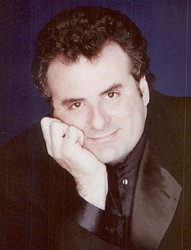A Noble Simon Boccanegra at the Met Opera
James Levine Conducts Live in HD Feb. 6
By: Susan Hall - Feb 02, 2010
Simon Boccanegra
By GiuseppeVerdi
Conductor: James Levine;
Production: Giancarlo del Monaco;
Cast features Adrianne Pieczonka, Marcello Giordani, Plácido Domingo, James Morris
James Levine conducts the Metropolitan Opera production of Verdi's 1881 version of Simon Boccanegra, a complex opera in which both politics and love are in play. It is an opera that is simple to understand in its beauty and texture. It will be broadcast Live in HD in theatres in the US and Canada on February 6. And in encores in the US on February 24th and in Canada on March 20th
Boccanegra, a former pirate and now Doge, is the Nelson Mandela of 14th century Italy -- making nice with enemies, bringing them together. Mandela was not a pirate as the Doge was, but surely some Afrikaners considered him one.
It takes Mandela-style peacemaking skills to rise above ancient feuds and rivalries. Of course warring was what Italian city-states were doing in Verdi's time. Verdi had briefly entered public political life. In 1861, pushed by the nationalist Cavour, who thought that monarchy conflicted with liberal principles, Verdi became the deputy for Borgo San Donnino (now Fidenza) in the first Italian parliament He held the post for four years, but attended sessions erratically.
Verdi's interest in politics is reflected in this opera. Multi layering of public and private life only enhances Boccanegra's power and inspires some of Verdi's most luscious composition, both for orchestra and voice.
Placido Domingo's character had a child with James Morris' daughter and this child, Adrianne Pieczonka, who James Morris claims as his own (but is really his granddaughter), has fallen in love with Placido Domingo's archenemy Adorno. This creates a problem for Adrianne/Amelia, who worries that her common birth may be a further strike against her, since Adorno is a noble. That straightened out, the duets, trios and other ensemble singing among this group is of great beauty.
Censors were a legitimate concern for Verdi. He supplied a complete prose sketch of the action, detailed because that is the way he worked with librettist Piave. After leaving clearance of Stiffelio to Piave, who didn't do the job, he only trusted himself. The exiled revolutionary, Giuseppe Montanelli, drafted several scenes. The premier was only moderately successful – the libretto was criticized. The La Scala premier was a fiasco.
Almost 20 years later, after a standoffish relationship between the composer and talented poet and composer Arrigo Boito, Verdi's publisher, with a little help from Mrs. Verdi, induced them to join forces. Verdi was reluctant to return to Boccanegra, which he found sad and monotonous. He came to share Boito's excitement over the revision. This alliance also produced the late, great operas Otello and Falstaff
The prologue and the final two acts, which the Met performs without intermission, were fine, but Act I needed a complete overhaul -- with particular emphasis on contrast and variety. One of Amelia's cabalettas is reduced to a few bars of recitative. The revised arias and duets between soprano Pieczonka and Marcello Giordani are perfectly beautiful.
When the Doge (Domingo) enters in the mutual recognition scene, 'Figlia!! a tal nome io palpito', varied in the new version to give the father and daughter distinct musical personas, we have soaring father-daughter tenderness and feeling.
The second scene of the first Act was completely re-written. There is a new stormy introduction, after which the Doge urges the Council to preserve peace between Genoa and Venice. A rioting crowd is heard outside demanding the death of patricians and the Doge. Amelia/Maria has been abducted, but she returns during the scene, refusing to point to her abductor. The Doge/ dad places a curse on the abductor and Paolo, who wishes to marry Amelia/Maria against her will, is forced to repeat the curse and falls to the ground in horror.
The new version was a hit at La Scala and has continued in the repertory of major opera houses since then. While it is sometimes said to be too dark (the curse word of today's opera critics) dark does not suit at all. The prologue set in a public square looks like a storm is coming and of course it does. But the Grimaldi palace courtyard where we meet Amelia, is bathed in sunlight and a blue sky. The council room and Doge's private quarters are all full of light with angels painted all over the ceiling.
In opera and life, good people often die or are murdered, so death can't be counted as dark. So many scenes in this opera, particularly the love scenes between Adorno and Amelia/Maria, and those between father and daughter, are of such satisfying and elevating beauty, that dark hardly seems the appropriate description. Complex perhaps, because we have love and politics enjoined. For me, this just doubles the pleasure.
The singing in this production is wonderful – Marcello Giordano lyric as Adorno, Domingo a majestic Boccanegra, and especially Adrianne Pieczonka as Amelia/Marie. Katrin Hilbe, a director who had worked with Pieczonka at Bayreuth (and seldom praises) wrote me about the soprano "Amazing. Wonderful. To die for."





